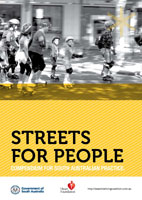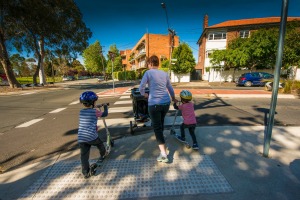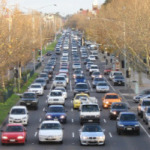Road management
"The need for provision and assessment of facilities for pedestrians has not been well-recognised until recent years. As a result there is an emerging need to cater for pedestrians in transport planning and traffic management in Australia and New Zealand to a greater extent than previously" (Austroads 2013)
Management of the road reserve is critical in facilitating walking. Road environments such as wide, high speed arterial roads can be hostile for pedestrians. Conversely, tree-lined streets with low traffic volumes and speeds provide pleasant environments for walking.
This section looks at the various ways councils can manage the road environment to promote walking.
In managing streetscapes it is important to remember that not all pedestrians are highly mobile adults. Councils need to work with the needs of children, seniors, vision impaired and others with limited mobility in mind.
General resources

- Excellent general guidance on how to promote walking (and cycling) in road management is provided by the Streets for People Compendium available from the South Australian Active Living Coalition.
- The Austroads 2013 report Guide Information for Pedestrian Facilities discusses how pedestrians are addressed in road management guidelines in Australia and overseas. It concludes that substantial improvement is required, including a greater focus on walking needs as perceived by pedestrians themselves.
- Detailed guidance on providing for pedestrians in the road environment is also provided by the WA Department of Transport Planning and designing for pedestrians guidelines.
- Official guidance on various aspects of road management relating to pedestrians is provided by the VicRoads Traffic Engineering Manual, Pedestrian Facilities Section.
Pedestrian safety
 Safe and convenient roundabout design (Port Phillip City Council)
Safe and convenient roundabout design (Port Phillip City Council)
Over the last five years, 219 pedestrians were killed on Victorian roads. For every pedestrian fatality, there are about 15 serious pedestrian injuries. Based on Australian data for 2008-09, pedestrians are more likely to sustain a high threat to life injury than any other road user group and have the longest episodes of care, with a mean length of stay of 7.6 days in hospital, compared with 4.8 days for car drivers (Australian Institute of Health and Welfare 2012).
Victoria is doing reasonably well in reducing deaths of car occupants, but not pedestrians. Between 2002 and 2011, fatalities for car drivers dropped 4% per annum, but pedestrian fatalities dropped less than 1% each year.
A good overview of pedestrian safety from an international perspective is provided by the International Transport Forum's Pedestrian Safety, Urban Space and Health. This suggests that up to one third of pedestrian fatalities and three quarters of injuries may be due to falls in public spaces, rather than collisions with vehicles. Fatalities arising from falls are generally those over 60 years of age. The World Health Organisation's Pedestrian Road Safety Manual also provides an international overview of evidence around road safety.
It is important to recognise that 'safe for pedestrians' does not necessarily mean 'good for pedestrians.' Unsignalised midblock pedestrian crossings may be perceived as less safe, for example, but they are very convenient for pedestrians as there is no delay in crossing the road. Successfully improving pedestrian safety, while also encouraging walking, requires a holistic approach, employing all of the methods detailed in this section. For more information, see Victoria Walks submission on the Victorian Road Safety Strategy 2012 and the Curtin-Monash Accident Research Centre's fact sheet Improving Pedestrian Safety. See also the intersections and crossings page for further techniques to improve pedestrian safety while promoting walking.
Traffic congestion
 Traffic on Hoddle Street (VicRoads photo)
Traffic on Hoddle Street (VicRoads photo)
Theoretically, traffic congestion is not a walking issue, but much of our road planning and management is driven by public, political and bureaucratic perceptions of traffic.
The current response to traffic congestion - attempting to build our way out of it by constructing more roads and freeways - will not solve congestion and discourages walking.
The Victorian Auditor General's report on traffic congestion provides a good critique of the current approach - see our news item.